► CAR’s 2024 Sports Car Giant Test
► The year’s best performance cars, rated
► Sponsored by Goodyear
Sensible is a relative construct when it comes to CAR’s annual performance car showdown, the Sports Car Giant Test. You join me, for instance, fresh off an early Eurotunnel and barely into an 800-mile trek to the south of France in the totally-new-for-2024 Ariel Nomad, half grinning, half grimacing as the elements bluster around its open sides.
If I appear still lost on the 2001 Paris-Dakar, I am in fact locked onto the rear bumper of a car that knows exactly where it’s heading – the Hyundai Ioniq 5 N. And the Hyundai’s remarkable for reasons other than the fact it has a navigation system. It’s the first electric car to ever receive an SCGT invite, having seen off the likes of Pininfarina’s remarkable Battista and Porsche’s wicked Taycan Turbo GT earlier this year. The Ioniq is certainly an altogether more sensible way to blow your mid-£60k budget than the Ariel.
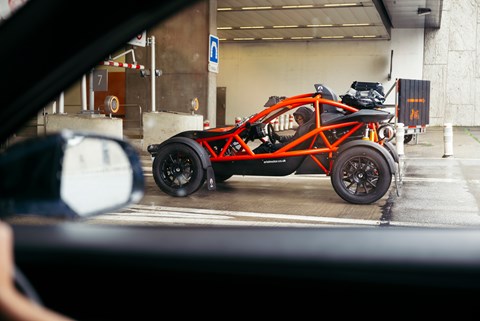
Prior experience says the hot EV will be a riot at Goodyear’s Mireval circuit. But EV charging, despite the Eurotunnel’s 210kW chargers, and compressed journey times rarely make happy bedfellows.
Such is the way of the world in 2024 that the Ariel and Hyundai live at the more affordable end of our fast-car spectrum. Half of our nine contenders slot between £40k and 70k, and some even have rear seats and hatchback tailgates, among them the Golf GTI Clubsport in our convoy. It’s the least expensive car on test at £42,155.
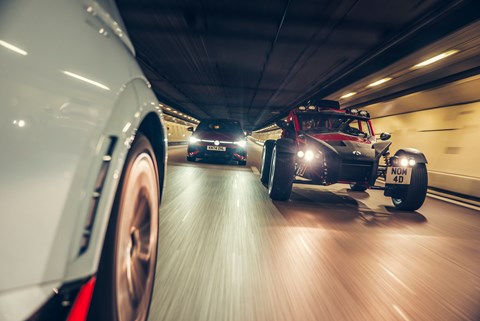
The Golf’s also a lovely place to be for this drive – a comfortable place from which to pull alongside the Ariel and laugh at the goggles and ear defenders its driver must wear. If you get cold in the Golf you can turn up the heat. When it runs low on fuel you can top up the tank. Genius.
The rest of our 2024 shortlist are heading from all over to rendezvous at a challenging circuit just a stone’s throw (or a really big off) from the Med. Least sensible among them are the £221k McLaren Artura Spider that promises to fix the excellent if flawed original Artura’s shortcomings, the brilliant new Aston Martin Vantage (£165k) and the Porsche 911 S/T, which packages the fury of the track-focused GT3 RS in a body that’s, well, just a bit more sensible (even if its £231,600 sticker price is unhinged).
Along with our convoy, the highly attainable Mustang GT and Toyota Yaris GR bring a fistful of fun to the £45k-£55k bracket, while the BMW M4 CS finds itself in fresh air at £120k.

But nothing compares with the Nomad; the precision of its tiny steering wheel, the eye-widening boost from its new 2.3 Ford turbo lump, the sophisticated ride on its Öhlins dampers, even the buzz you feel from brightening everyone else’s day. Best of all, despite the inclement weather, the latticework sides and open roof, I do not feel like I’ve driven through a river.
The Ioniq struggles with our plan to charge along the autoroute (200 miles is at the limit of its range at 110-120km/h), so we divert to a handy-ish shopping mall and what appears to be the ’80s. Thankfully an 80 per cent charge comes after a McDonald’s for everyone and a new jacket for photographer Olgun (spontaneous purchases are the comfort eating of EV ownership), and it’s time for my first stint in the engine-less Hyundai.
Early impressions say this is a large, long car trying its very best to look like a hot hatch, but initially I’m just glad of the calming isolation of the Hyundai’s vast cabin and the reassurance of its sat-nav. Then it takes just a slip road and a roundabout for the 5 to snap alive – a faster, stiffer steering rack and entirely new suspension bring real finesse to the way the, ahem, 2.2-tonner jinks into a curve, and even the simulated engine noise and gearshifts successfully deepen the connection. Save for the mezzanine driving position, I like it a lot.
At Clermont-Ferrand we head east towards Thiers, then plunge south through the Livradois-Forez national park on the D906, the road heaving and twisting as darkness falls and heavy rain returns.
Ted Welford maintains a sensible pace in the Nomad, the Golf’s just cruising through and I’m falling harder and harder for the Hyundai – who’d have thought an EV impersonating a combustion car could feel so authentic?

We roll into Le Puy-en-Velay just before our Ibis brasserie closes, but only at sunrise can we fully appreciate just how special this place is, with its patchwork of terracotta rooftops, maze of narrow streets and distinctive basalt breccias – volcanic chimneys that tower above the town. How they got planning permission for a chapel and a massive Virgin Mary on top is beyond me.
The drive south on the N88 is my first opportunity to try the new Mk8.5 Golf GTI Clubsport, which proves far more satisfying than the rather numb pre-facelift Golf R estate I ran last year. There’s a cleaner bite from its chassis and some proper perkiness from its 2.0-litre turbo four and DCT transmission combo, which still retains the refinement to make daily duties tolerable. Stand-outs include the supremely comfortable sports seats and our car’s optional adaptive dampers.
I do the final stint down the A75 in the Nomad as a fuzz of fog and spray reduces visibility to a few car lengths. When the road snakes alarmingly downhill at the foot of the Larzac plateau, I latch onto the Hyundai’s blazing foglights like a clingy child to a mother while the GTI plays rear gunner. It’s an almighty relief to reach Montpellier that evening.
Tomorrow promises better weather, the first of two days on road and track and – on this early evidence – a lot of fun.
By Ben Barry
The contenders
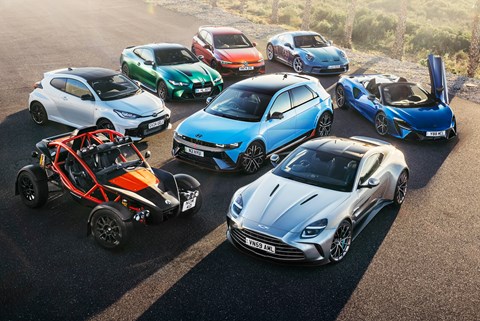
McLaren Artura Spider
More than simply an Artura with a folding roof, the Spider is a fresh start for McLaren’s impressive if glitchy V6 hybrid. Just how much better is it?
Price £221,500
Powertrain 7.4kWh battery, 2993cc twin-turbo V6, PHEV, eight-speed dual-clutch auto, rear-drive
Performance 690bhp @ 7500rpm, 531lb ft @ 2250rpm, 3.0sec 0-62mph, 205mph
Weight 1457kg (dry)
Efficiency 58.9mpg, 108g/km CO2
On sale Now
Read our McLaren Artura Spider review
Porsche 911 S/T
The lightest, purest expression of the 992.1 911, with GT3 RS power, a manual gearbox and more understated bodywork. A supercar scarer, but also the priciest car on test.
Price £231,600
Powertrain 3996cc flat-six, six-speed manual, rear-wheel drive
Performance 518bhp @ 8500rpm, 343lb ft @ 6300rpm, 3.7sec 0-62mph, 186mph
Weight 1380kg
Efficiency 17.6mpg, 313g/km CO2
On sale Now
Read our Porsche 911 S/T review
BMW M4 CS
Sharper and 20bhp more potent than an M4 Comp, not as wild or expensive as the two-seat, rear-drive CSL. Could the CS be the perfect all-round performance car?
Price £120,345
Powertrain 2993cc twin-turbo straight-six, eight-speed auto, all-wheel drive
Performance 544bhp @ 6250rpm, 479lb ft @ 2750rpm, 3.4sec 0-62mph, 188mph
Weight 1760kg
Efficiency 27.7mpg, 232g/km CO2
On sale Now
Toyota GR Yaris
Homologation special gets more power, updated chassis and a decent driving position for 2024. A little scrapper of a hot hatch that’ll take on anything.
Price £44,250
Powertrain 1618cc turbo three-cylinder, six-speed manual, all-wheel drive
Performance 276bhp @ 6500rpm, 288lb ft @ 3250rpm, 5.2sec 0-62mph, 143mph
Weight 1280kg
Efficiency 32.1-32.5mpg, 197g/km CO2
On sale Now
Hyundai Ioniq 5 N
Zero-emissions hot hatch is the most fun we’ve ever had in an EV. Can it shock our petrol-powered alternatives?
Price £65,000
Powertrain 84kWh battery, twin e-motors, all-wheel drive
Performance: 641bhp, 546lb ft, 3.4sec 0-62mph, 161mph
Weight 2235kg
Efficiency 2.93 miles per kWh, 278-mile range, 0g/km CO2
On sale Now
Read our Hyundai Ioniq 5 N review
Ariel Nomad
Atom’s itinerant cousin returns for a sequel with all-fresh engineering and Ford turbo power. No frills but all the thrills to keep everything honest.
Price £67,992
Powertrain 2267cc turbo four-cylinder, six-speed manual, rear-drive
Performance 260bhp @ 5900rpm, 284lb ft @ 2500rpm, 3.4sec 0-62mph, 134mph Weight 715kg
Efficiency n/a mpg, n/a g/km CO2
On sale Now
Read our Ariel Nomad review
VW Golf GTI Clubsport
The most focused GTI reboots with a Mk8.5 facelift and mission to inject more fun. Could its consistency and value make the toppy stuff look daft?
Price £42,155
Powertrain 1984cc turbo four-cylinder, seven-speed dual-clutch auto, front-wheel drive
Performance 296bhp @ 6000rpm, 295lb ft @ 2000rpm, 5.6sec 0-62mph, 156mph
Weight 1459kg
Efficiency 37.4mpg, 171g/km CO2
On sale Now
Read our VW Golf GTI Clubsport review
Aston Martin Vantage
New 656bhp Vantage is the ‘definitive front-engine, rear-wheel drive sports car’ claims Aston. But with this an equal-opportunities event, it faces all comers.
Price £165,000
Powertrain 3982cc twin-turbo V8, eight-speed manual, rear-wheel drive
Performance 656bhp @ 6000rpm, 590lb ft @ 2750rpm, 3.5sec 0-62mph, 202mph
Weight 1605kg (dry)
Efficiency 23.3mpg, 274g/km CO2
On sale Now
Read our Aston Martin Vantage review
Ford Mustang GT
Rear-drive muscle with a naturally-aspirated V8, manual gearbox and attainable price tag hasn’t even heard of the zeitgeist. Which is exactly why it’s here.
Price £55,725
Powertrain 5038cc V8, six-speed manual, rear-wheel drive
Performance 440bhp @ 7250rpm, 398lb ft @ 5100rpm, 5.3sec 0-62mph, 155mph
Weight 1808kg (est)
Efficiency 23.5mpg, 274g/km CO2
On sale Now
Read our Ford Mustang review
To the limit… and beyond
Well, how special is this? The Med sparkles a few miles out, while in the near distance Mireval’s many test routes glisten like a network of tributaries wending towards the sea. If a racetrack paddock enjoys a more spectacular vantage point, I’ve yet to see it.
We’re on the High Performance Circuit, a layout first minted for motorsport 50 years back but which could’ve been purpose-built for tyre development. No wonder Goodyear snapped it up in ’84. Fearsomely fast in places, demanding on the brakes in others, and with a tight, technical climb later in the lap, it covers more bases in two miles than some circuits do in three times the distance. Good job too, seeing as we’re here to whittle our nine cars down to three.
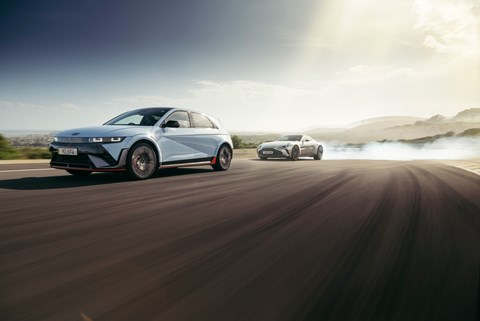
The Yaris GR seems an appropriate toe in the water – surefooted with its all-wheel drive, it’s not too punchy at 276bhp, nor too pricey at £44,250 if I have to buy it back as scrap (only joking).
A comprehensive refresh for 2024 includes a 19bhp boost for the 1.6-litre turbo triple, additional stiffness for both body and chassis, and the inclusion of the popular Circuit pack as standard equipment. Thankfully, a reworked interior also drops you some 25mm lower than the coach-driver perch of the original.
Immediately the Yaris imbues confidence – the accuracy and weighting of its steering, the strength of its brakes, the composure of the chassis, how it dances over kerbs so compliantly yet so gleefully it could be clicking its heels mid-air. The sheer fight in this triple-cylinder lump also astonishes – muscular down low, happy to rev to 6500rpm, it bursts with eager performance.
The Yaris is not perfect, partly because it has such a front-biased to neutral feel. Tap the triple’s surprising appetite for revs and it’s easy to unload the front and get its front tyres scrabbling – but shift up, surf the midrange and the drama slips away.
‘It just doesn’t rotate enough at the rear through all the phases of a corner and defaults to understeer,’ notes video man James Dennison. ‘I want more liveliness, like a Fiesta ST.’ Ah, RIP.
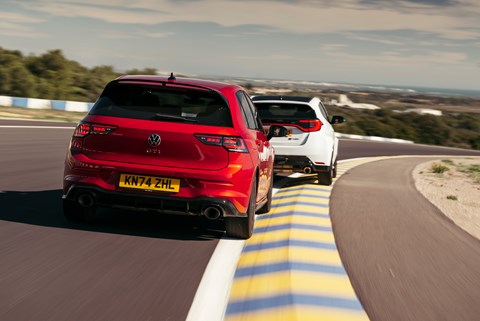
But the GR is mighty on our road loop. Perhaps calmer and less tingly of feel than the original, it’s still hardwired to the surface and feels unflappable, no matter the surface camber or raggedness. With its little three-cylinder engine always on the boil, its compact dimensions and all-wheel-drive grip, it’s the stuff of supercar cold sweats.
I take my first step into the 500bhp-plus club with the BMW M4 CS. On paper you receive little for your £33k premium over an M4 Competition. Power swells by 20bhp to 544bhp, new engine mounts, increased spring rates and revised camber settings channel more road feel, plus a carbon bonnet, titanium silencer and CSL alloys contribute to a trifling 15kg reduction at 1760kg. Adds up, though.
There’s a lighter, crisper sort of texture to the M4’s punchy helm, instantly making the chassis feel more connected. And while the twin-turbo six has all the sophistication and progression of the regular M4, the CS feels even faster than the small power-to-weight bump suggests, with torque forever and relentless urge. I blitz the 800-metre straight and arrive at Mireval’s blind first corner so quickly I keep triggering the ABS in a panic, only to realise the M4 can take a gentler squeeze and later apex in its stride.
This car’s running optional carbon ceramics so it’ll stop like it’s chained to a post but wears Pilot Sport 4S rubber rather than the standard ‘track tyres’ BMW promises.
All I can say is it must feel epic on that rubber, because the CS carves curves like you wouldn’t believe for a 1760kg front-engined coupe. Crucially – and unlike the CSL – it also retains M xDrive.
In 4WD Sport it reminds me of those Octopus-shaped sticky toys of the ’80s – throw it wherever and it just sticks, then works out how to get out of the mess. Switch to 2WD and it’ll hang at the daftest drift angles. Only the 5 N can compare to this shape-shifting chassis.
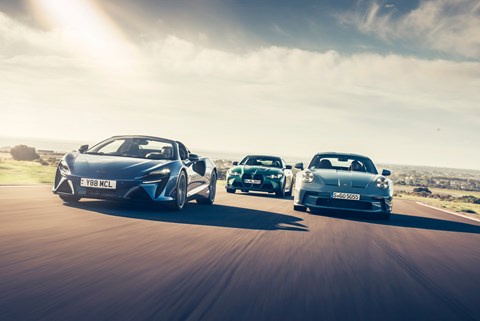
Later, when we explore our road loop, snaking through the darkness, the BMW’s a heady mix of grip, texture and endless power, even though – as our German contributor Johannes Riegsinger notes – it’s doing so much heavy lifting for its driver. One car to do everything, all year round? This.
If you want your 500bhp-plus to make you sweat, the 911 S/T could be the ticket. Yet another twist on the GT3 recipe and closest in spirit to the R of 2016, it combines the slightly more powerful GT3 RS engine, a six-speed manual gearbox with shorter gearing, no rear-wheel steering and a more understated body.
It’s the lightest and least filtered of the first-gen 992s, so much so that you don’t even get any driving modes, just switchable adaptive dampers (the S/T does not have the surprising polish of a GT3 RS). Proper old-school road racer.
‘In the M4 you sense the hours they’ve invested just fine tuning the engine note,’ notes Johannes, ‘but the 911 is pure machine. It’s raw, you hear everything and, when you drive, it makes you work hard to get the best from it.’
The S/T irritates both in traffic (graunchy single-mass flywheel, yappy-dog revs) and at a cruise (3000rpm at 70mph is a little busy), but the window between is a shard of brilliance straight from heaven.
You do not need to be going quickly to appreciate its talents but equally, the S/T thrives when it’s monstered. It takes me back to my skateboarding era – a stable platform that you can malleably work against the grit of the surface. Give me a few days and I’ll land a 360° pop shove-it.
At Mireval the 911 is sublime. I don’t miss rear-wheel steering in slower corners because it still feels so alert, but it’s definitely edgier in the faster stuff – load it up with just a little steering and you feel the weight of that flat-six in the tail, a sensation no doubt emphasised by reduced aero (though an active rear wing does deploy).
The S/T is constantly ready to tweak its line in response to your throttle, steering and brake inputs while that phenomenal six fizzes like Alka-Seltzer in lemonade and shrieks to 9000rpm like a Le Mans car. ‘Amazing engine, razor-sharp handling, and the manual ’box is a treat too – lovely short throw, nice tight gate,’ agrees James.
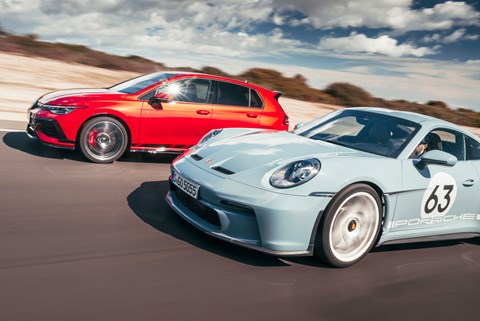
I need to sit down. In a Volkswagen. The Golf GTI’s focus on all-round competence has always been a mixed blessing, and the Mk8 hardly set pulses racing. But the Mk8.5 Clubsport is a return to form.
It gets off to a great start with its fabulously comfortable sports seats and nicely low-slung driving position, and builds on those foundations with energetic steering and an evolution of the EA888 2.0-litre turbo that’s strong low down and revs out energetically.
A DCT gearbox is compulsory, but its snappy shifts suit this 296bhp powertrain perfectly, as does extra fruitiness courtesy of the GTI Performance pack and its Akrapovic exhaust.
Handling is steadfast rather than adjustable, but the Clubsport’s blessed with great compliance over the kerbs, feels alert through left-right flicks and has bite enough from its front axle to both put down power and let you roll healthy speed into the apex.
Our car’s forged Warmenau alloys no doubt help the handling dexterity with their 20 per cent reduction in unsprung mass – a no-brainer for £1190, surely. Safe for a novice but with the smarts to entertain the more experienced, the Clubsport’s a great package.
Not long ago we’d have pitched a Hyundai i30 N into battle against a Golf GTI. But the Korean maker’s petrol hot hatches have disappeared so quickly we should probably call social services. These days the Ioniq 5 N is our substitute.
It’s already won CAR’s all-electric performance car test, and with 641bhp, only the Vantage and McLaren are more potent (but then nothing else comes close to its 2.2-tonne heft).
All the computer-game modes are such overkill I probably need a 12-year-old to tell me how to drive it, but I latch on to two: the simulated burble of a four-cylinder turbo, and N e-shift, which simulates an eight-speed dual-clutch auto right down to a torque map that builds through each ratio. Imagine driving a highly realistic simulator on a racetrack and you’re almost there.
Hot-hatch looks mentally condition you to expect a slightly nose-heavy balance and relatively compact dimensions. But the 84kWh battery puts most weight low and between the axles, and a 5 is almost M4 long, not GTI short. Its extended wheelbase is no doubt key to immense stability on track, but the Hyundai can also be way more reactive than the Yaris or the Golf, including a full-on drift mode that acts as a kind of reverse carbon offset to vaporise tyres. Even without drift mode engaged, it is refreshingly playful, Mr Dennison arcing gracefully past me with wisps of smoke coiling from the tyres.
The Hyundai also translates its fun between road and track, and it throws comfort, the serenity of zero emissions (at the tailpipe!) and acres of cabin and luggage space into the bargain.
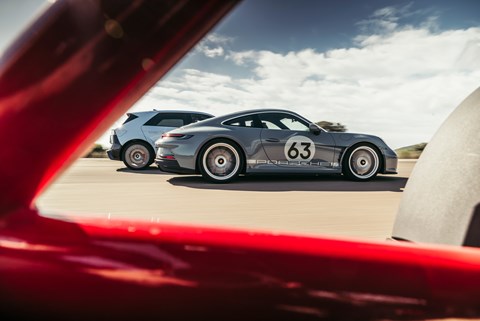
‘Brilliant fun,’ enthuses James after some very smoky laps. ‘I love how it shifts the conversation away from outright acceleration and puts the emphasis on the corners. It’s as though everything happens in slow motion, plus it manages its weight really well. It’s like a big, electric Focus RS.’ Ah, RIP Mk2.
If a hot-hatch simulation leaves you cold, the Mustang is so analogue it probably collects vinyl and wind-up watches. We’ve invited the entry-level GT partly because it’s over £12k cheaper than a Dark Horse at £55,725 but still packs a 5.0-litre V8 with 440bhp. And partly because I wasn’t convinced the Dark Horse justified its premium when I back-to-backed them on the press launch.
Piers Ward has driven the ’Stang 800 miles straight down here and fell for its effortless, long-legged gait (‘I even had to drop to fourth gear on some of the long uphill stretches of autoroute near Montpellier,’ he notes of the tall gearing), and at a cruise it does feel big and isolated and perhaps too lazy to entertain.
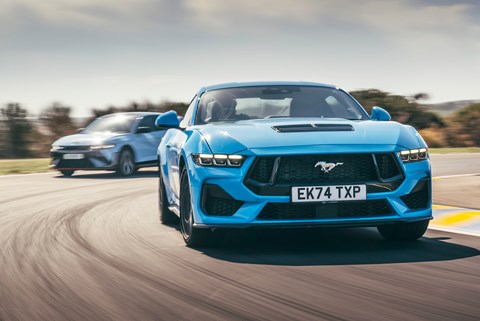
But the Mustang has more depth than that. Its steering is significantly sharpened over previous generations to pep up direction changes, there’s character in spades and it even puts its power down ably in filthy conditions – thank natural aspiration, a long-travel throttle and peak torque of 398lb ft waiting until 5100rpm to join the party. How people keep crashing them out of car meets is mystifying.
If the ’Stang is good on the road, the revelation here is just how well it copes around Mireval. It never shakes its doughy feel, but in Track mode (on optional adaptive dampers) the body control tightens and I instantly feel happy to push hard – benignly balanced, forgiving of big shifts in weight transfer and with so much traction you can just let that V8 rip everywhere, it’s great fun.
There’s acres of potential to make a hotter, sharper version, the gulf between third and fourth gear feels big enough to slot a 3.5 in (a Dark Horse’s cogs are shorter and more tightly stacked), and this chassis could easily deal with a load more shove. But as a road car to use for occasional trackdays it’s immensely appealing. And just try finding another V8, manual, rear-drive coupe for £55k. Impossible.
Aston will sell you something a little bit similar for £165k, though. Its Vantage has been updated for 2024, but to call this second-generation model a makeover is to undersell the scope of the re-engineering wrought here. Every panel bar the roof and doors is new, the Mercedes-AMG-sourced twin-turbo V8 gets a 30 per cent boost to 656bhp, gearshifts are punchier, the final drive shorter, plus there’s additional torsional rigidity for the structure, new Bilstein DTX dampers and Michelin Pilot Sport 5S tyres. Oh, and the interior now looks posh enough to go toe-to-toe with a 911.
For longer road trips and urban commutes, there’s no question the Vantage is superior to the 911 S/T. It creeps forwards so delicately in traffic it could be tip-toeing on creaky floorboards. Prod the throttle and the V8 bubbles like molten chocolate.
So, it’s classy, and when I turn up the wick on a sinuous back road it’s also epic – lovely clean steering response, nice flat body, great gobs of performance so long as you keep 2900rpm minimum on the dial, and gear ratios stacked like pancakes so you can do exactly that. Plus it has bundles more character than a 911 Turbo S, its closest rival in Porsche’s line-up.
James gets his track laps in before me and comes back grinning, if not entirely convinced it merits Aston’s caveat-heavy ‘definitive front-engine, rear-wheel-drive sports car’ billing. ‘Excellent on the road, but not quite as good on track, where it can feel a little flat-footed. But it’s still really good,’ he sums up. ‘Nice balance, plenty of opportunities to have fun… I like it a lot.’
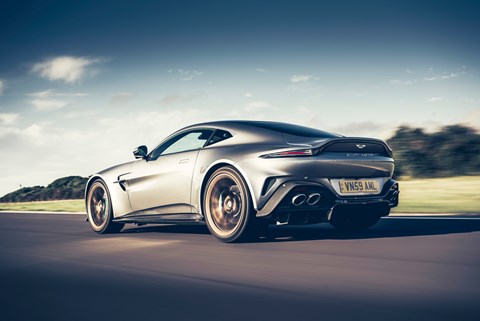
He’s right, but I actually think the Vantage feels better on Mireval’s faster sweeps than it did on the press launch at Circuito Monteblanco. It holds its line particularly well through fast turns with the mass of all that big V8 feeling pushed back in the nose, plus the brakes have bite and staying power, and the scope of the performance is just huge.
It does feel like the chassis is working hard to check rebound movements, though, and it gets a little thuggish if you fly solo with 590lb ft churning through the rear axle (though multi-stage traction control does ably marshal it). Like the Mustang, there’s a load of headroom here for a sharper version. Or you just need an Ariel Nomad alongside it in your garage.
In the simplest terms an Ariel Atom track car turned into an off-road buggy, the new Nomad looks much like the original launched in 2016. But everything is new bar the fuel filler flap, pedals and steering column. Most notably, the tubular steel chassis is chunkier, helping boost torsional rigidity by more than 60 per cent, and there’s a new 2.3-litre Ford turbo engine. Standard performance tops out at 260bhp, but our car also gets a cockpit-adjustable ECU so you can tweak performance up to 305bhp – an £1800 option.
It’s a very different unit from the revvy, naturally-aspirated Honda fours Ariel has used for 25 years. But the slug of midrange torque perfectly suits the Nomad’s less frantic nature, plus it’s forever characterful and revs keenly too. Predictably, Golf GTI power in a chassis weighing half as much essentially doubles the punch and it’s fast like you wouldn’t believe.
Initially the lack of grip and smudgy feel from all-terrain rubber is a little alarming. But after a cautious first lap things change.
The Nomad rides kerbs beautifully with its relaxed wheel articulation, and when it slides and the suspension compresses over the outside wheels the rebound is so progressive it simply settles back on a level like a rubber duck emerging from bathwater. (Ariel’s philosophy generally has been to reduce the original Nomad’s rather comedic roll angles, something that’s more pronounced on this car’s road-focused Öhlins, not the Bilsteins recommended for off-roading.)
All the other controls have a similarly mechanical, precise feel, from the firm but progressive squeeze of the brakes, to a gearlever that you pull like a trapdoor release, to how the steering has purposeful weight but never descends into kickback, even when really loaded up. Tweaking and pushing and twirling my way round a lap, I feel like I’m playing the Nomad as much as driving it. Consensus says it’s too compromised to make the final, though.
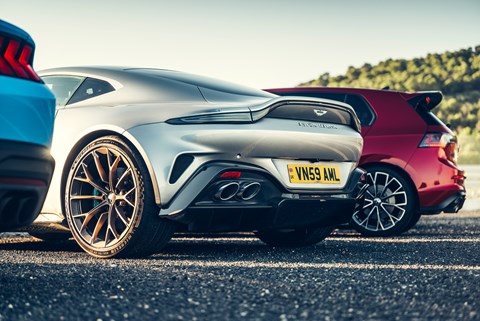
‘It’s incredible fun on track and arguably the most fun in short bursts, but it asks you to compromise in return,’ notes James. ‘It’s clearly a weekend car, but I can’t bring myself to put it higher than mid-table given you get comparable levels of fun from some of the others but without the drawbacks.’
The McLaren Artura Spider is an altogether more serious proposition, and it’s hard not to feel a pang of fear as it sits in the pits warming up boisterously.
More than just an Artura with a retractable hardtop, the Spider represents a fresh start for McLaren’s first series-production hybrid supercar. The fundamentals remain unchanged – 3.0-litre twin-turbo V6 boosted by an axial-flux e-motor – but power rises 20bhp to 690bhp, proactive damping control responds 90 per cent faster, there are new engine mounts, gearshifts some 25 per cent swifter and a revised exhaust intended to make spines tingle and geese pimple.
There’s breadth to the McLaren that nothing here can match. You can drop the roof and whoosh about on electric propulsion, or summon all 690bhp to blitz 0-124mph in just 8.4 seconds and – thanks to the carbon tub – enjoy handling as crisp as the coupe’s.
I liked the original Artura, but this car drives like it’s stepped up a segment. It flows through turns wide and flat like storm water down a gulley, and glides over terrible surfaces that get almost everything else jiggling. Its hydraulically-assisted steering is so perfect – accurate, feelsome, filtered enough to dial out the noise – that it’s quite possibly the industry benchmark right now. Sitting low, the Artura’s low cowl falling away in front of you, I’d need to be skimming over the landscape in a wingsuit to feel more immersed.
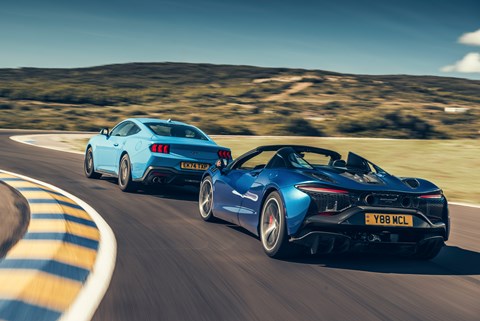
But this is also a more polished, less scary sort of drive than the 750S positioned above it. The hybridised V6 is key, because rather than lag then a violent kick of boost, everything happens in a more progressive way in the Artura.
I have two criticisms – the chassis is so competent and the midrange performance so strong that on the road I rarely got close to the 7500rpm high notes, so the engine becomes the least important part of the equation. It’s less exciting than the fizzy Porsche. Brake feel is also poor when you’re merely brushing the pedal on a road drive.
None of that matters on the racetrack, where brake inputs are larger and revs are always singing, and at Mireval the Artura is phenomenally rapid, beautifully balanced and surprisingly forgiving. A shriller sound and snappier shifts deepen the engagement.
I just wish the front axle had more bite in the slower stuff, even if it is far from frustratingly understeery – again it’s that more approachable nature versus the rather fearsome 750S. Dennison is smitten. ‘It’s more cohesive and more exciting than before but still wonderfully precise and incredibly approachable,’ he enthuses. ‘If it came down to one last drive, I’d struggle to turn down the keys to this.’
That night we’re unanimous that the McLaren and 911 have to progress to the shootout, but which car joins them is less certain. The Vantage isn’t far off, but can’t quite rise to the occasion as consistently as the M4 or Ioniq.
We set out wondering if an electric car could hold a candle to the best petrol sports cars… and the Ioniq gets really close. If it was more i30 N-sized and could shed a little weight – the heft is definitely a downside – then it might even sneak in to the final three. A mighty effort from Hyundai, then, but the podium is petrol.
By Ben Barry
5 things you didn’t know about tyres
Mireval is Goodyear’s largest proving ground in Europe, handling tyre testing for just about every vehicle on the planet. Remi Granier, head of the facility, is the man to explain the science behind the black circles.
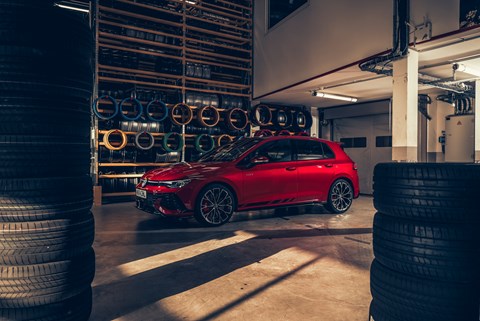
Dedicated ‘electric car tyres’ don’t mean a great deal…
… or not to Goodyear, at least. You’ll have probably seen bespoke ‘EV’ tyres labelled by some brands but Goodyear says the rolling resistance of all its tyres is low enough to suit an EV, and it’s already developed more wear-resistant tyres to cope with the increased weight. ‘All our tyres are designed for EVs, and they all have a low rolling resistance,’ says Granier.
Sunny side up
‘Guys, it’s raining, let’s get out testing the tyres in the wet’. Not a chance. Goodyear prefers bone dry conditions in which to do its wet testing. The quantity – and quality – of water needs to be a known factor when carrying out evaluations. If they do the testing in winter or summer, it has to be the same quality of water, or the results won’t be as useful. ‘Rainfall affects so many parameters that we can’t control,’ says Granier.
The patterns don’t match, deliberately
Goodyear splits tyres into three categories – High Performance (HP), Ultra High Performance (UHP) and Ultra Ultra High Performance (UUHP). The HP rubber will go on a Polo, UHP on a 5-series and UUHP on a 911, for example. One easy way of identifying how extreme a tyre is: see how symmetrical the tread pattern is. A perfectly symmetrical tyre is usually the sign of a more normal or all-weather tyre, whereas performance-orientated rubber will be asymmetric as the two sides – and particularly the shoulders of the tyre – will be different. The more extreme the car, the more extreme the body movement, so the tyres need to have a stiffer construction and a different pattern at each side to compensate.
Specifics are key
When a manufacturer creates a new car, it’ll send a wish list to tyre manufacturers, with the specific requirements and characteristics. Mercedes, for example, wants a tyre for more open-road driving, whereas Alfa Romeo wants something extremely direct, so that as soon as you shift the steering wheel, the car moves. Milimetres count. With up to 15 different compounds and 200 materials within a tyre, the scope for variety is almost endless.
Heads, shoulders, knees and toes
The shoulder of a tyre dictates how you come to a stop on a warm summer’s day. When you apply brake pressure, the front of the car dives, but the dynamic weight shift puts more pressure on the tyre’s shoulders as the suspension compresses. The centre tread is still in contact, but if you look at the pressure distribution, it’s all on the shoulder. That’s why you’ll see fewer grooves on a summer tyre than a winter tyre. Fewer grooves means more stiffness, more stiffness means better stability under braking.
By Ted Welford
Three become one
In the gorges that carve through the Lozère region of southern France, birds flutter angrily away from their comfortable perches, incensed at the disturbance as 18 cylinders whap past. Autumnal leaves that have only just started to settle on the smooth tarmac scatter in the wake of each car, flicked up and over flanks of smooth, speeding metal.
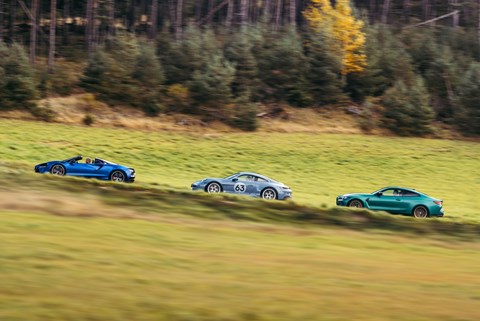
McLaren follows BMW follows Porsche, drivers cocooned, concentrating, focusing. The road is wide enough, but not comfortably so, and it needs precise inputs in all three cars to ensure that the podium shootout for CAR’s Sports Car Giant Test 2024 doesn’t end awkwardly early.
Because this is crunch time: three very different cars and only one winner. BMW M4 CS versus McLaren Artura Spider versus Porsche 911 S/T – a breadth that demonstrates just how varied this year’s crop of performance cars is.
Winding our way out of the shadow of the Millau viaduct (pronounced mee-oo, according to the locals, which is news to me), I start in the M4, which makes the podium ahead of the Ioniq and Vantage on account of a scintillating evening road drive after we’d spent 12 hours on track.
If you need a car to monster distances in all weathers, the CS is it. Partly that’s down to the security of the four-wheel drive, partly it’s down to the relative comfort of the enveloping seats that you don’t need a crane to lower yourself into, as well as the ease of the torque converter transmission. But it’s also because it’s an easy car to gel with – there’s a directness to the communication that’s been missing from some of the more recent M cars. It doesn’t feel so unwieldy, and it’s surprising how quickly you can be on it.

The pre-programmed M1 function is ace (the two M buttons on the wheel allow you to save and quickly access all your favourite settings), with the steering, throttle and transmission in Sport Plus but with the dampers in Comfort. As Ben Barry noted from the track, the BMW arcs crisply through a curve and you can easily balance it on the brakes into the apex – there’s a sense of connection through the chassis that breeds confidence. Despite its 1760kg kerbweight, it doesn’t flip-flop through a left-right flick and you don’t feel like you’re trying to play catch-up with it – the car responds as you want it to.
If only the steering could match this. I don’t mind how light it feels in your hands, even in the sportier modes, but there’s a vagueness to it around the dead-ahead that you don’t get in the Artura or 911. And why can’t M division just give us a normal steering wheel, rather than the fat modern things that have all the appeal of shaking hands with Mr Blobby?
Contrast that with the Artura. Lowering myself into it and then reaching forward to grasp the alcantara-covered steering wheel is a revelation next to the podge of the M4. You need a moment of sitting there to absorb it all. The excellent seating position; low and gripped in all the right places. The brilliant view forward; clear but with purpose. The way the dials and wheel move towards you together, leaving no doubt as to the intent here: you need all the information as close as possible.
Turn the Artura Spider’s steering wheel slightly while stationary; oh, this is going to be good. Even without moving you can tell this car offers feedback in spades.
We hit some beautiful sweeping roads beyond Massegros Causses Gorges and the Artura is glorious. The sight lines are sufficiently good to let us feel safe to extend the V6 hybrid, and the way the steering responds is life-affirming – loads of feedback, zero corruption. We should be dedicating Bank Holidays to McLaren’s engineers.
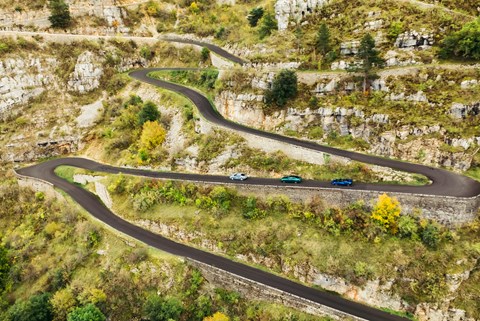
The Artura has a lovely hip roll through a corner that allows you to tip it in, let the body move and find its stable place, and then power through. There’s movement, but not too much.
Flow is crucial in this car; it’s at its best on an analogue road rather than a stop-start digital one. If you need to start to lean on the brakes and punch in and out of corners, the Artura isn’t so impressive. This is mainly down to the brakes themselves – they have impressive stopping power but lack delicacy at the top of the travel, so you’re never quite sure where they’ll bite. In a turn, this doesn’t allow you to rotate the car on the brakes as much as the other finalists, because you’re less confident as to where the tipping point is.
Over time, you do learn to trust them more, or at least adapt to them. After an hour of smooth tarmac, the Artura delights with its brilliant compromise of ride and handling, something that no rival can match. As James Dennison said after the track sessions, it’d be difficult to dispute that the McLaren is the car to take home, with a wonderful blend of theatre and everyday ability.
Contrast that with the gravelly Porsche 911 S/T, a car that chunters even at idle, grumbling at you like an angry man in the Post Office queue. But extend the naturally-aspirated flat-six past 5000rpm and – holy moly – this thing takes on an attitude and rawness that makes racing cars look flaccid. I love the fact that even when the ignition is switched off, the analogue revcounter is clearly displayed in the dash, the car telling you it’s ready to go even before it’s fired up.
Southern France’s empty roads winding through sheer rock faces that climb to the clouds make this a good place to drink in the sound of the Porsche. Closely following in the M4, Ben Barry winds down the BMW’s windows the better to appreciate it as the autoblip makes the revs soar each time it changes down.
A welcome pause to breathe and collect our thoughts in the pretty village of La Malène. Nestled alongside the river Tarn and between imposing, vast cliffs arcing up into the sky, the threatening rocks contrast with beautiful stone houses that blend into the limestone surrounds while elderly couples wander by the river, the Tarn bubbling gently over smooth pebbles.
Peace. Shattered.
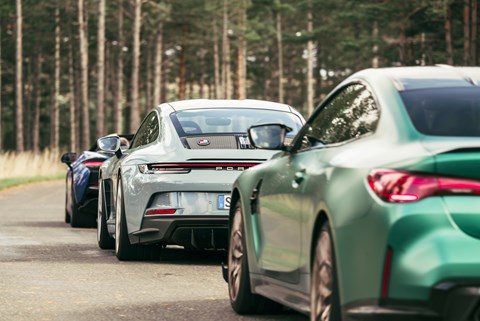
As we clamber up the cliff face on the far side of the river, the road becomes a series of hairpin bends that make the Stelvio Pass look straight. I immediately regret being in the 911, as it’s not easy through here, constantly cocking a wheel and chuntering. The climb is long and confined to first and second; you can feel the Porsche getting angrier at the restraint.
Then we emerge into a scene that wouldn’t look out of place on the American prairies, all big fields and open vistas. Let loose, the Porsche delights. The sense of rotation from the rear-biased weight transfer is wonderful, reminding you of the engineering underpinning the car without threatening to acquaint you with a hedge. It gives the car an organic quality that no torque vectoring, however clever, could manage.
This car feels like a high-water mark for Porsche. It’s one that will keep revealing more of itself gradually, rewarding an owner one drive at a time, whereas the M4 and Artura come to you more immediately. The others are easier to drive, more instantly accessible and flattering. But the Porsche’s depth is more intriguing.
Take the way the nose grips. As first, because of the ease with which the Porsche rotates, you’re wary of going in too hard. But the more you lean on it into an apex, the more it gives, gripping and rewarding in a beautiful tango with the corner.
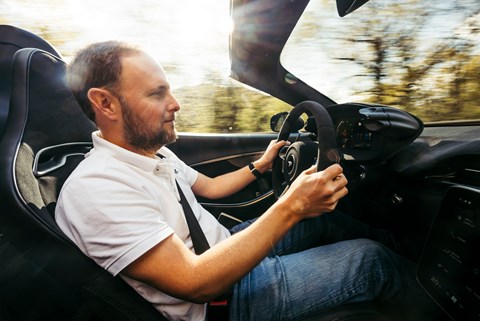
I clamber back into the McLaren, keen to compare them directly on the same road. The ride quality! It’s a joy, filtering out stuff that the Porsche can’t mask. Would one of these two please do something really annoying so that I can make a call on the verdict…
After 10 hours, it’s a dead heat between the McLaren and the Porsche, with the BMW consigned to third place – it’s superb, but it can’t keep delivering rewards the way the other two can.
One last drive is needed, as the sun ducks below yet another mountain range and the temperature starts to fall. Shadows lengthen, senses heighten. It’s Porsche time.
This is what confirms it for me – that moment you jump in the 911 and can instantly feel the precision flowing from every touch point. It’s instant and dialled in, with no slack at any moment; like driving a purpose-built racing car that reacts the instant the thought enters your head.
The road curls ahead, unsighted around a forested mountain side, and not ideal conditions in the fading light. But this is a drive I’ll remember for years, as the 911 S/T encourages me to delve deeper and deeper into its reserves, joyously lapping up all the feedback.
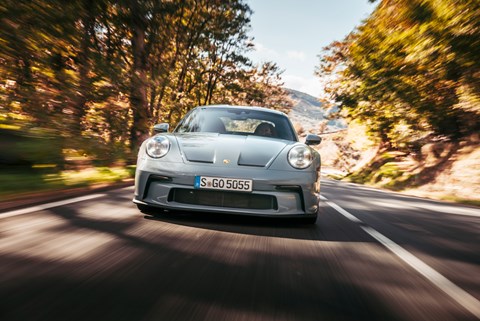
I really ought to turn back and head to the hotel but the S/T eggs me further and further on, rendering me a helpless addict. I’m well aware of the sensible option and yet I’m totally unable to ignore the current path. It just feels so damn good.
The breadth of the Artura’s ability is staggering and highly commendable but this test isn’t about that. It’s a more specific set of criteria, about finding the year’s most rewarding car. And here it is, the best version of 2024’s best sports car: the 911 S/T.
By Piers Ward